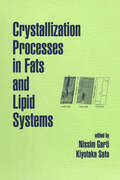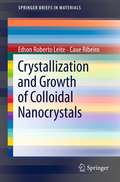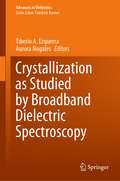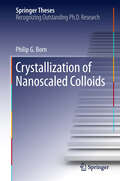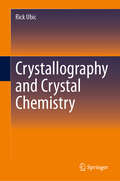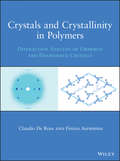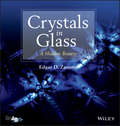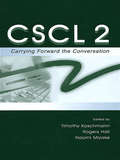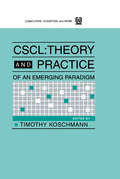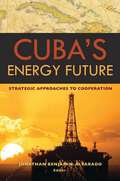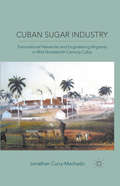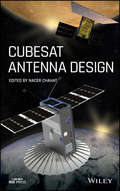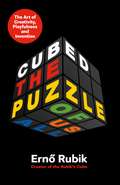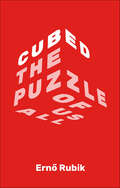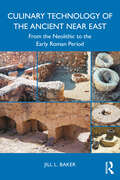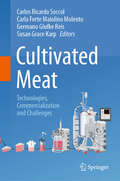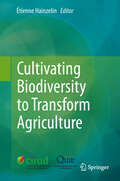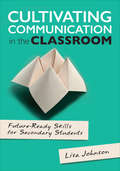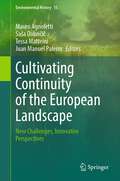- Table View
- List View
Crystallization Processes in Fats and Lipid Systems
by Nissim Garti Kiyotaka SatoAn exploration of new and emerging techniques, processes and applications in the behaviour, crystallization, and polymorphic transformations of fats and oils. It presents research and information on advanced analytical tools, computer modelling, molecular structures, mixing behaviour, and interactions with seeding materials and surfactants. The con
Crystallization and Growth of Colloidal Nanocrystals (SpringerBriefs in Materials)
by Edson Roberto Leite Caue RibeiroSince the size, shape, and microstructure of nanocrystalline materials strongly impact physical and chemical properties, the development of new synthetic routes to nanocrystals with controlled composition and morphology is a key objective of the nanomaterials community. This objective is dependent on control of the nucleation and growth mechanisms that occur during the synthetic process, which in turn requires a fundamental understanding of both classical nucleation and growth and non-classical growth processes in nanostructured materials. Recently, a novel growth process called Oriented Attachment (OA) was identified which appears to be a fundamental mechanism during the development of nanoscale materials. OA is a special case of aggregation that provides an important route by which nanocrystals grow, defects are formed, and unique--often symmetry-defying--crystal morphologies can be produced. This growth mechanism involves reversible self-assembly of primary nanocrystals followed by reorientation of the assembled nanoparticles to achieve structural accord at the particle-particle interface, the removal of adsorbates and solvent molecules, and, finally, the irreversible formation of chemical bonds to produce new single crystals, twins, and intergrowths. Crystallization and Growth of Colloidal Nanocrystals provides a current understanding of the mechanisms related to nucleation and growth for use in controlling nanocrystal morphology and physical-chemical properties, and is essential reading for any chemist or materials scientist with an interest in using nanocrystals as building blocks for larger structures. This book provides a compendium for the expert reader as well as an excellent introduction for advanced undergraduate and graduate students seeking a gateway into this dynamic area of research.
Crystallization as Studied by Broadband Dielectric Spectroscopy (Advances in Dielectrics)
by Tiberio A. Ezquerra Aurora NogalesThis book presents new approaches that offer a better characterization of the interrelationship between crystalline and amorphous phases. In recent years, the use of dielectric spectroscopy has significantly improved our understanding of crystallization. The combination of modern scattering methods, using either synchrotron light or neutrons and infrared spectroscopy with dielectrics, is now helping to reveal modifications of both crystalline and amorphous phases. In turn, this yields insights into the underlying physics of the crystallization process in various materials, e.g. polymers, liquid crystals and diverse liquids. The book offers an excellent introduction to a valuable application of dielectric spectroscopy, and a helpful guide for every scientist who wants to study crystallization processes by means of dielectric spectroscopy.
Crystallization of Lipids: Fundamentals and Applications in Food, Cosmetics, and Pharmaceuticals
by Kiyotaka SatoAn authoritative reference that contains the most up-to-date information knowledge, approaches, and applications of lipid crystals Crystallization of Lipids is a comprehensive resource that offers the most current and emerging knowledge, techniques and applications of lipid crystals. With contributions from noted experts in the field, the text covers the basic research of polymorphic structures, molecular interactions, nucleation and crystal growth and crystal network formation of lipid crystals which comprise main functional materials employed in food, cosmetic and pharmaceutical industry. The authors highlight trans-fat alternative and saturated-fat reduction technology to lipid crystallization. These two issues are the most significant challenges in the edible-application technology of lipids, and a key solution is lipid crystallization. The text focuses on the crystallization processes of lipids under various external influences of thermal fluctuation, ultrasound irradiation, shear, emulsification and additives. Designed to be practical, the book’s information can be applied to realistic applications of lipids to foods, cosmetic and pharmaceuticals. This authoritative and up-to-date guide: Highlights cutting-edge research tools designed to help analyse lipid crystallization with the most current and the conventional techniques Offers a thorough review of the information, techniques and applications of lipid crystals Includes contributions from noted experts in the field of lipid crystals Presents cutting-edge information on the topics of trans-fat alterative and saturated-fat reduction technology Written for research and development technologists as well as academics, this important resource contains research on lipid crystals which comprise the main functional materials employed in food, cosmetic and pharmaceutical industry.
Crystallization of Nanoscaled Colloids (Springer Theses)
by Philip G. BornThis thesis deals with the processes that create ordered assemblies from disordered nanoparticles. Ordered packings of nanoscale particles can exhibit unusual properties. This work investigates the self-assembly of such particles, a process widely employed for the generation of ordered structures, but not yet well understood. In situ methods are used to observe the assembly of sub-micron polymer lattices and sub-10 nm gold particles into crystalline monolayers and aggregates. On the basis of these results, the book develops new models that describe the competition between different influences, such as thermal agitation and directional forces. It suggests necessary criteria that lead to the emergence of order.
Crystallography and Crystal Chemistry
by Rick UbicThis textbook introduces readers to the language, concepts, and tools of crystallography, as well as many aspects of crystal chemistry. Important topics, such as bonding, electronegativity, lattice energy, symmetry operations, crystal defects, and structure-property relationships are covered. Worked examples are included where appropriate. By uniquely combining elements of crystallography and crystal chemistry, the text is a useful and accessible resource for students across many disciplines. Chapter summaries and example problems are included to optimize use by students and faculty in both graduate and undergraduate curricula. Historical context to relevant discoveries and biographical sketches of many of the scientists involved in the development of this field are also provided to expand the student’s knowledge of both solid-state science and scientists.
Crystals and Crystallinity in Polymers
by Finizia Auriemma Claudio De RosaProvides the tools needed to master and apply the fundamentals of polymer crystallographyUsing core concepts in physics, chemistry, polymer science and engineering, this book sheds new light on the complex field of polymer crystallography, enabling readers to evaluate polymer crystallization data and determine the best methods to use for their investigations. The authors set forth a variety of tested and proven methods for analyzing ordered and disordered structures in polymer crystals, including X-ray diffraction, electron diffraction, and microscopy. In addition to the basics, the book explores several advanced and emerging topics in the field such as symmetry breaking, frustration, and the principle of density-driven phase formation.Crystals and Crystallinity in Polymers introduces two new concepts in crystallinity and crystals in synthetic polymers. First, crystallinity in polymeric materials is compatible with the absence of true three-dimensional long-range order. Second, the disorder may be described as a structural feature, using the methods of X-ray scattering and electron diffraction analysis.The book begins by introducing the basic principles and methods for building structural models for the conformation of polymer crystal chains. Next, it covers:Packing of macromolecules in polymer crystalsMethods for extracting structural parameters from diffraction dataDefects and disorder in polymer crystalsAnalytical methods for diffuse scattering from disordered polymer structuresCrystal habitInfluence of crystal defects and structural disorder on the physical and mechanical properties of polymeric materialsCrystals and Crystallinity in Polymers examines all the possible types of structural disorder generally present in polymer crystals and describes the influence of each kind of disorder on X-ray and electron diffraction patterns. Its comprehensive, expert coverage makes it possible for readers to learn and apply the fundamentals of polymer crystallography to solve a broad range of problems.
Crystals in Glass: A Hidden Beauty
by E. D. ZanottoA "must-have" for materials engineers, chemists, physicists, and geologists, this is one of the first "coffee-table" books in the field of glass science. Containing over fifty beautiful micrographs, the book reflects 35 years of original research by a highly regarded authority in the field. It contains 50 slides culled from tens of thousands of images on glass crystal nucleation, growth, and crystallization. The images represent glass crystallization mechanisms, including internal, surface, homogeneous, heterogeneous, and eutectic, crystal nucleation and growth.
Cscl 2: Carrying Forward the Conversation
by Timothy Koschmann Naomi Miyake Rogers HallCSCL 2: Carrying Forward the Conversation is a thorough and up-to-date survey of recent developments in Computer Supported Collaborative Learning, one of the fastest growing areas of research in the learning sciences. A follow-up to CSCL: Theory and Practice of an Emerging Paradigm (1996), this volume both documents how the field has grown and fosters a meaningful discussion of how the research program might be advanced in substantive ways. Recognizing the long-standing traditions of CSCL work in Europe and Japan, the editors sought to broaden and expand the conversation both geographically and topically. The 45 participating authors represent a range of disciplinary backgrounds, including anthropology, communication studies, computer science, education, psychology, and philosophy, and offer international perspectives on the field. For each chapter, the goal was not only to show how it connects to past and future work in CSCL, but also how it contributes to the interests of other research communities. Toward this end, the volume features a "conversational structure" consisting of target chapters, invited commentaries, and author responses. The commentaries on each chapter were solicited from a diverse collection of writers, including prominent scholars in anthropology of education, social studies of science, CSCW, argumentation, activity theory, language and social interaction, ecological psychology, and other areas. The volume is divided into three sections: *Part I explores four case studies of technology transfer involving CSILE, one of the most prominent CSCL projects. *Part II focuses on empirical studies of learning in collaborative settings. *Part III describes novel CSCL technologies and the theories underlying their design. Historically, there has been a certain amount of controversy as to what the second "C" in CSCL should represent. The conventional meaning is "collaborative" but there are many C-words that can be seen as relevant. With the publication of this volume, "conversational" might be added to the list and, in this spirit, the book might be viewed as an invitation to join a conversation in progress and to carry it forward.
Cscl: Theory and Practice of An Emerging Paradigm
by Timothy KoschmannThis book, about a newly emerging area of research in instructional technology, has as its title the acronym "CSCL." Initially, CSCL was chosen as an acronym for Computer-Supported Collaborative Learning. However, some would argue that "collaborative" is often not a descriptive term for what learners do in instructional settings; further, as the field develops, the technology used to support collaboration may not always involve computers, at least not in the direct ways they have been used to support instruction in the past. To avoid getting bogged down in this terminological debate, this book uses CSCL as a designation in its own right, leaving open to interpretation precisely what words it stands for. The authors talk a great deal about the theory underlying their work. In part, this is because that is what they were asked to do, but it is also an indication of the state of the field. In an established paradigm in which the theories and methods are well agreed upon, such discussion is less central. CSCL, however, has not yet reached the stage of "normal" science. There is much to be worked out yet. This book is offered with the hope that it will help to define a direction for future work in this field. The chapters appear in alphabetical order (except for the introductory chapter and the afterword) -- not for lack of a better way to organize the chapters, but rather because the organizational possibilities are too numerous and this order does not privilege one over another. By not imposing a topical organizing structure on this collection, it is hoped that readers will feel freer to explore the chapters in a way that best suits their needs. COPY FOR BIND-CARD CD-ROM info ................................. There is an accompanying CD-Rom for this proceedings that will become available September 1998. Purchasers of the proceedings may obtain a copy of this CD-ROM at no cost by contacting Lawrence Erlbaum Associates, Inc. phone: (201) 236-9500 toll-free: 1-800-9-BOOKS-9 (1-800-926-6579) 9am-5pm EST fax: (201) 236-0072 e-mail: orders@erlbaum.com Web site: www.erlbaum.com address: 10 Industrial Avenue, Mahwah, NJ 07430-2262 The CD-ROM was funded through a grant from the National Science Foundation.
Ctrl + Z: The Right to Be Forgotten
by Meg Leta JonesA gripping insight into the digital debate over data ownership, permanence and policy“This is going on your permanent record!” is a threat that has never held more weight than it does in the Internet Age, when information lasts indefinitely. The ability to make good on that threat is as democratized as posting a Tweet or making blog. Data about us is created, shared, collected, analyzed, and processed at an overwhelming scale. The damage caused can be severe, affecting relationships, employment, academic success, and any number of other opportunities—and it can also be long lasting. One possible solution to this threat? A digital right to be forgotten, which would in turn create a legal duty to delete, hide, or anonymize information at the request of another user. The highly controversial right has been criticized as a repugnant affront to principles of expression and access, as unworkable as a technical measure, and as effective as trying to put the cat back in the bag. Ctrl+Z breaks down the debate and provides guidance for a way forward. It argues that the existing perspectives are too limited, offering easy forgetting or none at all. By looking at new theories of privacy and organizing the many potential applications of the right, law and technology scholar Meg Leta Jones offers a set of nuanced choices. To help us choose, she provides a digital information life cycle, reflects on particular legal cultures, and analyzes international interoperability. In the end, the right to be forgotten can be innovative, liberating, and globally viable.
Cuba After Castro: Legacies, Challenges, and Impediments
by Bruce Hoffman Kevin F. Mccarthy Gabriella Gonzalez Louay Constant Edward Gonzalez Jeffery C. TannerWhen the end of the Castro era arrives, the successor government and the Cuban people will need to answer certain questions: How is Castro's more than four-decade rule likely to affect a post-Castro Cuba? What will be the political, social, and economic challenges Cuba will confront? What are the impediments to Cuba's economic development and democratic transition? The authors examine Castro's political legacies, Cuba's generational and racial divisions, its demographic predicament, the legacy of a centralized economy, and the need for industrial restructuring.
Cuba's Energy Future
by Jonathan Benjamin-Alvarado Vicki HuddlestonApproaching an uncertain future without Fidel Castro, and still reeling from a downturn at the end of the cold war, Cuba must act decisively to improve its economy and living conditions. One of the major challenges facing the impoverished island nation is securing access to energy resources that are sufficient to meet the needs of its revitalization and development goals. What steps can Cuba take to achieve both short- and long-term energy sustainability and self-sufficiency? In this timely analysis, Jonathan Benjamin-Alvarado and his colleagues answer that question. Cuba's Energy Future sets the geostrategic context within which Cuba is operating. The book provides an overview of the evolving relations among Caribbean states and explains why Cuba and its longtime nemesis the United States should look for ways to cooperate on developing energy resources. The possible role of oil companies is explored, as is Cuba's energy relationship with Hugo Chavez's Venezuela.The second section of Cuba's Energy Future features economic and technical appraisals, economic projections, and trends affecting Cuba's energy needs, including oil and natural gas potential, the country's antiquated electric power sector, and the role of biofuels such as sugarcane ethanol. The concluding section focuses on the conditions necessary for, and the mutual benefits of, greater cooperative engagement with the United States.Contributors: Juan A. B. Belt (Chemonics International, formerly USAID), Jonathan Benjamin-Alvarado (University of Nebraska-Omaha and University of Georgia), Amy Myers Jaffe (Rice University), Jorge R. Piñón (Florida International University), Ronald Soligo (Rice University).
Cuba's Energy Future: Strategic Approaches to Cooperation
by Jonathan Benjamin-AlvaradoApproaching an uncertain future without Fidel Castro, and still reeling from a downturn at the end of the cold war, Cuba must act decisively to improve its economy and living conditions. One of the major challenges facing the impoverished island nation is securing access to energy resources that are sufficient to meet the needs of its revitalization and development goals. What steps can Cuba take to achieve both short- and long-term energy sustainability and self-sufficiency? In this timely analysis, Jonathan Benjamin-Alvarado and his colleagues answer that question. Cuba's Energy Future sets the geostrategic context within which Cuba is operating. The book provides an overview of the evolving relations among Caribbean states and explains why Cuba and its longtime nemesis the United States should look for ways to cooperate on developing energy resources. The possible role of oil companies is explored, as is Cuba's energy relationship with Hugo Chavez's Venezuela.The second section of Cuba's Energy Future features economic and technical appraisals, economic projections, and trends affecting Cuba's energy needs, including oil and natural gas potential, the country's antiquated electric power sector, and the role of biofuels such as sugarcane ethanol. The concluding section focuses on the conditions necessary for, and the mutual benefits of, greater cooperative engagement with the United States.Contributors: Juan A. B. Belt (Chemonics International, formerly USAID), Jonathan Benjamin-Alvarado (University of Nebraska-Omaha and University of Georgia), Amy Myers Jaffe (Rice University), Jorge R. Pi??n (Florida International University), Ronald Soligo (Rice University).
Cuban Sugar Industry: Transnational Networks and Engineering Migrants in Mid-Nineteenth Century Cuba
by Jonathan Curry-MachadoNineteenth-century Cuba led the world in sugar manufacture and technological innovation was central to this. Through the story of a group of forgotten migrant workers who anonymously contributed to Cuba's development, this book explores the development of the Cuban sugar industry and how the country became bound into global networks.
CubeSat Antenna Design (JPL Space Science and Technology Series)
by Nacer ChahatPresents an overview of CubeSat antennas designed at the Jet Propulsion Laboratory (JPL) CubeSats—nanosatellites built to standard dimensions of 10cm x 10 cm x cm—are making space-based Earth science observation and interplanetary space science affordable, accessible, and rapidly deployable for institutions such as universities and smaller space agencies around the world. CubeSat Antenna Design is an up-to-date overview of CubeSat antennas designed at NASA’s Jet Propulsion Laboratory (JPL), covering the systems engineering knowledge required to design these antennas from a radio frequency and mechanical perspective. This authoritative volume features contributions by leading experts in the field, providing insights on mission-critical design requirements for state-of-the-art CubeSat antennas and discussing their development, capabilities, and applications. The text begins with a brief introduction to CubeSats, followed by a detailed survey of low-gain, medium-gain, and high-gain antennas. Subsequent chapters cover topics including the telecommunication subsystem of Mars Cube One (MarCO), the enabling technology of Radar in a CubeSat (RainCube), the development of a one-meter mesh reflector for telecommunication at X- and Ka-band for deep space missions, and the design of multiple metasurface antennas. Written to help antenna engineers to enable new CubeSate NASA missions, this volume: Describes the selection of high-gain CubeSat antennas to address specific mission requirements and constraints for instruments or telecommunication Helps readers learn how to develop antennas for future CubeSat missions Provides key information on the effect of space environment on antennas to inform design steps Covers patch and patch array antennas, deployable reflectarray antennas, deployable mesh reflector, inflatable antennas, and metasurface antennas CubeSat Antenna Design is an important resource for antenna/microwave engineers, aerospace systems engineers, and advanced graduate and postdoctoral students wanting to learn how to design and fabricate their own antennas to address clear mission requirements.
Cubed: The Puzzle Of Us All
by Erno RubikErno Rubik inspires us with what he's learned in a lifetime of creating, curiosity, and discovery.
Cubed: The Puzzle of Us All
by Erno RubikThe first book by the reclusive inventor of the world’s most iconic puzzle THE RUBIK’S CUBE. Erno Rubik inspires us with what he’s learned in a lifetime of creating, curiosity, and discovery.Erno Rubik was a child when he first became obsessed with puzzles of all kinds. “Puzzles,” he writes, “bring out important qualities in each of us: concentration, curiosity, a sense of play, the eagerness to discover a solution.” To Rubik puzzles aren’t just games—they’re creativity machines. He encourages us to embrace our inner curiosity and find the puzzles that surround us in our everyday lives. “If you are determined, you will solve them,” he writes. Rubik’s own puzzle, the Cube, went on to be solved by millions worldwide for over forty years, become one of the bestselling toys of all time, and to be featured as a global symbol of intelligence and ingenuity.In Cubed, Rubik covers more than just his journey to inventing his eponymous cube. He makes a case for always being an amateur—something he has always considered himself to be. He discusses the inevitability of problems during any act of invention. He reveals what it was like to experience the astonishing worldwide success of an object he made purely for his own play. And he offers what he thinks it means to be a true creator (hint: anyone can do it). Steeped in the wisdom and also the humility of a born inventor, Cubed offers a unique look at the imperfect science of creation.
Culinary Technology of the Ancient Near East: From the Neolithic to the Early Roman Period
by Jill L. BakerCulinary Technology of the Ancient Near East discusses the technical aspects of meal preparation, cooking, and baking in the ancient Near East, exploring a wide range of topics including kitchens, cooking equipment, cooking and baking vessels, and serving and eating utensils. Chapters explore and describe the culinary technologies and techniques employed by the peoples of the ancient Near East from the Neolithic to the Early Roman period, considering their unique and pioneering contributions to the development and evolution of gastronomic devices and apparatus and highlighting some of the foods prepared by them, recognizing their application and influence in contemporary cooking and baking. Baker brings together in a single volume what is known about the culinary technology of the ancient Near East based on the archaeological, textual, historic, and scientific data drawn from a wide range of studies and discusses this data in terms of its cultural, historic, and socio-economic context. She emphasizes these technologies as the foundation upon which modern culinary technology is based and applies relevant ancient techniques to modern systems. Overall, the volume acknowledges the ingenuity of the ancient mind in order to understand their culinary technology, which in turn helps us better understand our own and apply these, and new, ideas to the present and future. This is a fascinating study suitable for students and scholars working on food and households in the ancient Near East, as well as those working on the history of food, cooking and dining, and the history of technology more broadly.
Culpability
by Bruce HolsingerA suspenseful family drama about moral responsibility in the age of artificial intelligence. <P><P> When the Cassidy-Shaws’ autonomous minivan collides with an oncoming car, seventeen-year-old Charlie is in the driver’s seat, with his father, Noah, riding shotgun. In the back seat, tweens Alice and Izzy are on their phones, while their mother, Lorelei, a world leader in the field of artificial intelligence, is absorbed in her work. Yet each family member harbors a secret, implicating them all in the tragic accident. <P><P> During a weeklong recuperation on the Chesapeake Bay, the family confronts the excruciating moral dilemmas triggered by the crash. Noah tries to hold the family together as a seemingly routine police investigation jeopardizes Charlie’s future. Alice and Izzy turn strangely furtive. And Lorelei’s odd behavior tugs at Noah’s suspicions that there is a darker truth behind the incident—suspicions heightened by the sudden intrusion of Daniel Monet, a tech mogul whose mysterious history with Lorelei hints at betrayal. When Charlie falls for Monet’s teenaged daughter, the stakes are raised even higher in this propulsive family drama that is also a fascinating exploration of the moral responsibility and ethical consequences of AI. <P><P> Culpability explores a world newly shaped by chatbots, autonomous cars, drones, and other nonhuman forces in ways that are thrilling, challenging, and unimaginably provocative.
Cultivated Meat: Technologies, Commercialization and Challenges
by Carlos Ricardo Soccol Carla Forte Maiolino Molento Germano Glufke Reis Susan Grace KarpCultivated meat is an emerging substitute for conventional meat that is not associated with animal farming and slaughtering. Instead, animal cells are cultivated in bioreactors and post-processed into “artificial” meat products. Although this new technology solves several ethical and environmental problems, there are techno-economic challenges that need to be addressed to make the commercial-scale production of cultivated meat a real perspective. This book addresses fundamental aspects of new food systems, animal cell culture and cultivated meat production, including cell lines, culture media, microcarriers and scaffolds, bioreactors, downstream processes, formulation, packaging, quality control, scale-up, and waste management. Also, aspects related to commercialization, market, patents, legislation, global and regional policies, and sustainability metrics such as life-cycle assessment, together with a bioeconomy perspective analysis, are reviewed. Finally, case studies are presented and the challenges and future prospects for cultivated meat production are proposed. This book is a collection of 21 chapters written by specialists in the field.
Cultivating Biodiversity to Transform Agriculture
by Étienne HainzelinHow can cultivated plant biodiversity contribute to the transformation and the "ecologization" of agriculture in Southern countries? Based on extensive field work in the Southern countries, a great deal of scientific progress is presented in all areas affecting agriculture (agronomy, plant breeding and crop protection, cultivation systems, etc. ) in order to intensify the ecological processes in cultivated plots and at the scale of rural landscapes.
Cultivating Communication in the Classroom: Future-Ready Skills for Secondary Students (Corwin Teaching Essentials)
by Lisa Ann JohnsonBuilding 21st Century communication skills Students are expected to be innovators, creative thinkers, and problem solvers. But what if they can't communicate their ideas persuasively? Knowing how to share ideas is as crucial as the ideas themselves. Unfortunately, many students don’t get explicit opportunities to hone this skill. Cultivating Communication in the Classroom will help educators design authentic learning experiences that allow students to practice their skills. Readers will find: Real world insights into how students will be expected to communicate in their future careers and education Strategies for teaching communication skills throughout the curriculum Communication Catchers for igniting ideas
Cultivating Communication in the Classroom: Future-Ready Skills for Secondary Students (Corwin Teaching Essentials)
by Lisa Ann JohnsonBuilding 21st Century communication skills Students are expected to be innovators, creative thinkers, and problem solvers. But what if they can't communicate their ideas persuasively? Knowing how to share ideas is as crucial as the ideas themselves. Unfortunately, many students don’t get explicit opportunities to hone this skill. Cultivating Communication in the Classroom will help educators design authentic learning experiences that allow students to practice their skills. Readers will find: Real world insights into how students will be expected to communicate in their future careers and education Strategies for teaching communication skills throughout the curriculum Communication Catchers for igniting ideas
Cultivating Continuity of the European Landscape: New Challenges, Innovative Perspectives (Environmental History #15)
by Mauro Agnoletti Saša Dobričič Tessa Matteini Juan Manuel PalermThis edited volume reviews 20 years’ worth of research under the European Landscape Convention. The authors from the research network UNISCAPE offer readers insights into their combined efforts to carry out and support the goals of a sustainable European landscape. 20 years after defining these original goals, the editors make landscape ecology and management, a cornerstone for the debate on a 21st century Europe. The numerous contributions cover the three major areas of Landscape Policy and Governance, Landscape Design and Time and Observing Landscape. The pan-European approach highlights the strength of international collaboration and interdisciplinary thinking.This book offers the collected knowledge as a working tool for researchers, scholars and professionals in landscape ecology.
